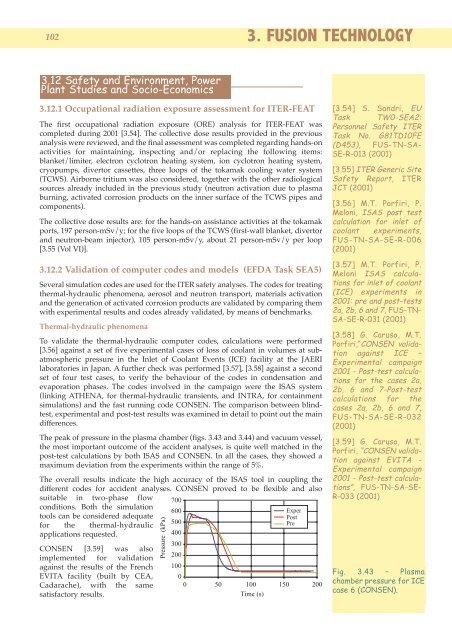1. magnetic confinement - ENEA - Fusione
1. magnetic confinement - ENEA - Fusione
1. magnetic confinement - ENEA - Fusione
Create successful ePaper yourself
Turn your PDF publications into a flip-book with our unique Google optimized e-Paper software.
102<br />
3. FUSION TECHNOLOGY<br />
3.12 Safety and Environment, Power<br />
Plant Studies and Socio-Economics<br />
3.12.1 Occupational radiation exposure assessment for ITER-FEAT<br />
The first occupational radiation exposure (ORE) analysis for ITER-FEAT was<br />
completed during 2001 [3.54]. The collective dose results provided in the previous<br />
analysis were reviewed, and the final assessment was completed regarding hands-on<br />
activities for maintaining, inspecting and/or replacing the following items:<br />
blanket/limiter, electron cyclotron heating system, ion cyclotron heating system,<br />
cryopumps, divertor cassettes, three loops of the tokamak cooling water system<br />
(TCWS). Airborne tritium was also considered, together with the other radiological<br />
sources already included in the previous study (neutron activation due to plasma<br />
burning, activated corrosion products on the inner surface of the TCWS pipes and<br />
components).<br />
The collective dose results are: for the hands-on assistance activities at the tokamak<br />
ports, 197 person-mSv/y; for the five loops of the TCWS (first-wall blanket, divertor<br />
and neutron-beam injector), 105 person-mSv/y, about 21 person-mSv/y per loop<br />
[3.55 (Vol VI)].<br />
3.12.2 Validation of computer codes and models (EFDA Task SEA5)<br />
Several simulation codes are used for the ITER safety analyses. The codes for treating<br />
thermal-hydraulic phenomena, aerosol and neutron transport, materials activation<br />
and the generation of activated corrosion products are validated by comparing them<br />
with experimental results and codes already validated, by means of benchmarks.<br />
Thermal-hydraulic phenomena<br />
To validate the thermal-hydraulic computer codes, calculations were performed<br />
[3.56] against a set of five experimental cases of loss of coolant in volumes at subatmospheric<br />
pressure in the Inlet of Coolant Events (ICE) facility at the JAERI<br />
laboratories in Japan. A further check was performed [3.57], [3.58] against a second<br />
set of four test cases, to verify the behaviour of the codes in condensation and<br />
evaporation phases. The codes involved in the campaign were the ISAS system<br />
(linking ATHENA, for thermal-hydraulic transients, and INTRA, for containment<br />
simulations) and the fast running code CONSEN. The comparison between blindtest,<br />
experimental and post-test results was examined in detail to point out the main<br />
differences.<br />
The peak of pressure in the plasma chamber (figs. 3.43 and 3.44) and vacuum vessel,<br />
the most important outcome of the accident analyses, is quite well matched in the<br />
post-test calculations by both ISAS and CONSEN. In all the cases, they showed a<br />
maximum deviation from the experiments within the range of 5%.<br />
The overall results indicate the high accuracy of the ISAS tool in coupling the<br />
different codes for accident analyses. CONSEN proved to be flexible and also<br />
suitable in two-phase flow<br />
conditions. Both the simulation<br />
tools can be considered adequate<br />
for the thermal-hydraulic<br />
applications requested.<br />
CONSEN [3.59] was also<br />
implemented for validation<br />
against the results of the French<br />
EVITA facility (built by CEA,<br />
Cadarache), with the same<br />
satisfactory results.<br />
Pressure (kPa)<br />
700<br />
600<br />
500<br />
400<br />
300<br />
200<br />
100<br />
Exper<br />
Post<br />
Pre<br />
0<br />
0 50 100 150 200<br />
Time (s)<br />
[3.55] ITER Generic Site<br />
Safety Report, ITER<br />
JCT (2001)<br />
[3.56] M.T. Porfiri, P.<br />
Meloni, ISAS post test<br />
calculation for inlet of<br />
coolant experiments,<br />
FUS-TN-SA-SE-R-006<br />
(2001)<br />
[3.54] S. Sandri, EU<br />
Task TW0-SEA2:<br />
Personnel Safety ITER<br />
Task No. G81TD10FE<br />
(D453), FUS-TN-SA-<br />
SE-R-013 (2001)<br />
[3.57] M.T. Porfiri, P.<br />
Meloni ISAS calculations<br />
for inlet of coolant<br />
(ICE) experiments in<br />
2001: pre and post-tests<br />
2a, 2b, 6 and 7, FUS-TN-<br />
SA-SE-R-031 (2001)<br />
[3.58] G. Caruso, M.T.<br />
Porfiri,“CONSEN validation<br />
against ICE –<br />
Experimental campaign<br />
2001 - Post-test calculations<br />
for the cases 2a,<br />
2b, 6 and 7-Post-test<br />
calculations for the<br />
cases 2a, 2b, 6 and 7,<br />
FUS-TN-SA-SE-R-032<br />
(2001)<br />
[3.59] G. Caruso, M.T.<br />
Porfiri, “CONSEN validation<br />
against EVITA -<br />
Experimental campaign<br />
2001 - Post-test calculations”,<br />
FUS-TN-SA-SE-<br />
R-033 (2001)<br />
Fig. 3.43 – Plasma<br />
chamber pressure for ICE<br />
case 6 (CONSEN).













